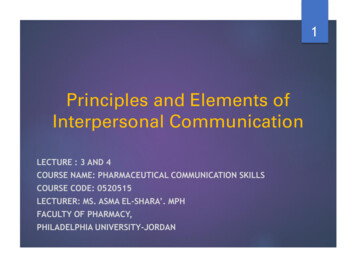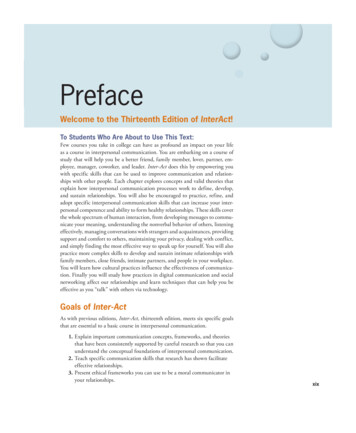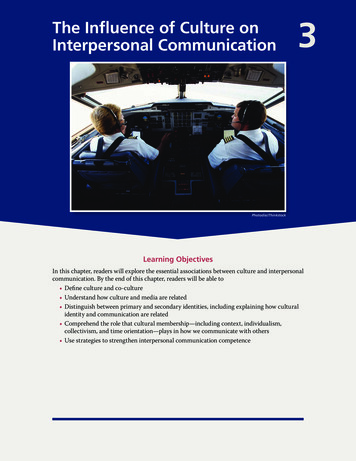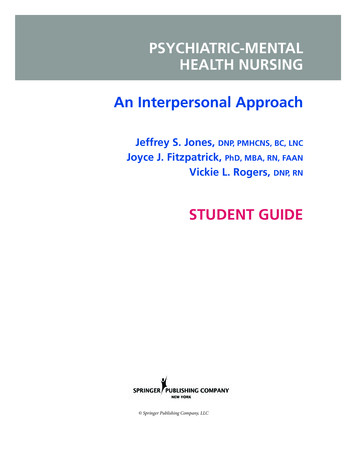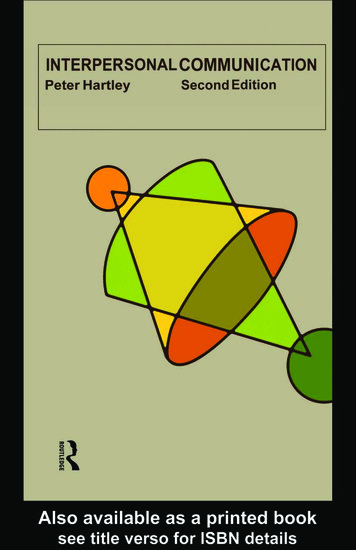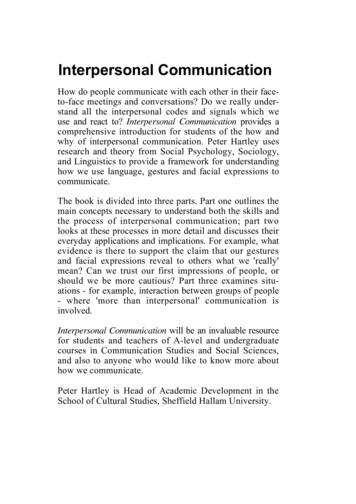
Transcription
Interpersonal CommunicationHow do people communicate with each other in their faceto-face meetings and conversations? Do we really understand all the interpersonal codes and signals which weuse and react to? Interpersonal Communication provides acomprehensive introduction for students of the how andwhy of interpersonal communication. Peter Hartley usesresearch and theory from Social Psychology, Sociology,and Linguistics to provide a framework for understandinghow we use language, gestures and facial expressions tocommunicate.The book is divided into three parts. Part one outlines themain concepts necessary to understand both the skills andthe process of interpersonal communication; part twolooks at these processes in more detail and discusses theireveryday applications and implications. For example, whatevidence is there to support the claim that our gesturesand facial expressions reveal to others what we 'really'mean? Can we trust our first impressions of people, orshould we be more cautious? Part three examines situations - for example, interaction between groups of people- where 'more than interpersonal' communication isinvolved.Interpersonal Communication will be an invaluable resourcefor students and teachers of A-level and undergraduatecourses in Communication Studies and Social Sciences,and also to anyone who would like to know more abouthow we communicate.Peter Hartley is Head of Academic Development in theSchool of Cultural Studies, Sheffield Hallam University.
InterpersonalCommunicationPeter HartleyLondon and New York
First published 1993by Routledge11 New Fetter Lane, London EC4P 4EESimultaneously published in the USA and Canadaby Routledge29 West 35th Street, New York, NY 10001Reprinted 1995, 1996Routledge is an International Thomson Publishing company 1993 Peter HartleyPrinted and bound in Great Britain byT. J. Press (Padstow) Ltd, Padstow, CornwallAll rights reserved. No part of this book may be reprinted or reproduced orutilized in any form or by any electronic, mechanical, or other means, nowknown or hereafter invented, including photocopying and recording, or inany information storage or retrieval system, without permission in writingfrom the publishers.British Library Cataloguing in Publication DataA catalogue record for this book is available from the British LibraryLibrary of Congress Cataloguing in Publication DataA catalogue record for this book is available from the Library of CongressISBN 0-415-01385-2 (pbk)
ContentsAcknowledgementsviForewordviiSection A:Deciding what we meanby interpersonal communication1Defining interpersonal communication12The process of interpersonal communication173The skills of interpersonal communication334Communication skills in context57Section B:Understanding the componentsof interpersonal communication5The social context796Social identity1077Social perception1278Codes149Section C:Moving beyond the interpersonal9Communication and groups10 Looking back and forward173203213IndexV
AcknowledgementsThanks are due to many people who helped in developingthis book. Needless to say I am responsible for any flaws inthe final version. Special thanks go to: Guy Fielding, who collaborated on the initialoutline Andrew Beck, Gary Radford, and Jane Weston,who commented on various drafts Julia, James and David, who provided variouscombinations of inspiration and practical help Jane Armstrong and Rebecca Barden, for theirpatience and encouragement well beyond thecall of dutyvi
ForewordIntroductions to textbooks can range from a brief paragraphto mini-novels which tell you almost everything which is inthe rest of the book. Avoiding these extremes, I have simplytried to answer a few questions which may help you decidewhether you actually want to read any further.What are the aims of this book?The main aim is to provide a basic introductory text oninterpersonal communication, ie face-to-face communication between two people. So I have tried to: explain the special or distinctive characteristicsof interpersonal communication identify the component parts of interpersonalcommunication explain how these components relate to oneanother explain the most important features of theskills involved in communicating with otherpeople contrast the characteristics of interpersonalcommunication with other forms of communicationAlthough the main concepts and theories are drawn fromresearch in the social sciences, I have tried to avoid socialscience jargon unless it really helps to express the arguments. My aim was to make this text readable and interesting.How is the book organised?The major sectionsIn section A, I try to establish a coherent framework forunderstanding interpersonal communication. As well asvii
Interpersonal Communicationoffering a definition and model of the process, I discuss themajor skills involved and show how these different approaches to the subject are related.Section B provides a more detailed analysis of the majorcomponents of interpersonal communication. Section Cintroduces situations which involve other people but wherethere are processes over and above the ones outlined insection B. For example, communication in groups is notthe same as communicating with one other person - thereare different influences at work.Within chaptersEach chapter is sub-divided into major sections which arelisted at the beginning of each chapter. Each major sectionfocusses on one important question or issue.At the end of each chapter, there is a list of notes whichincludes: details of references cited in the text further comments for anyone wishing to explore the topic in more detail references and suggestions for further reading.What is the best way to read this book?This may seem a nonsensical question. Surely you simplyread any book from beginning to end. I disagree. That maybe the way to read a novel on a train journey but is not theway we read many books. This text will be read by differentpeople for different purposes and so you may wish to choosea different approach. For example:If you are reading this simply from general interest in thetopic, then I suggest that you read Chapters 1 and 2 fairly quickly concentrate on the aspects that interest you inthe remaining chaptersviii
Foreword ignore the notes unless anything strikes you asparticularly interestingIf you are reading this as a student on a course, then I suggestthat you read Section A first read subsequent chapters in the order in whichthey crop up in your course when you read a chapter you skim-read it firstbefore going through it more slowly and checking the notesWhatever your approach, I hope you find this book helpfuland interesting. And that you find some ideas which you canuse to make your own communication more satisfying andeffective.Language and sexismIn my own teaching, I warn students to avoid sexist language and expressions. So I have tried to practise what Ipreach. In this book, "he" is always male and "she" is alwaysfemale, except in a few of the direct quotes from otherauthors who have obviously not read Miller and Swift.Peter HartleyOctober 1992Notes1Anyone who is not convinced that sexist languageshould be avoided both for the sake of accuracy andfairness is referred to this excellent book:C. Miller and K. Swift (1989) The Handbook of NonSexist Writing, 2nd edn, The Women's Pressix
Section ADeciding whatwe mean byinterpersonalcommunication
1DefininginterpersonalcommunicationIn this chapter, I shall: introduce the definition of interpersonalcommunication which is used throughoutthis book outline a number of propositions aboutinterpersonal communication which can bedeveloped from this definition and whichhave important practical and theoreticalimplications1
Interpersonal CommunicationHow can we define interpersonalcommunication?Most books which can be used as textbooks start with achapter which tries to define the subject matter and approach. This is an obvious place to start if you are completelynew to the subject. But what about a text on communication?Surely we all know what communication is? Isn't it a majorpart of all our daily lives? One writer has gone so far as tosay that:1all social interaction is necessarily communicativeand any social process presumes a communicationprocessIn other words, anything we do with other people mustinvolve communication.If communication is so "universal", then perhaps I canassume that everyone knows what it is, and move straighton to the next chapter! Unfortunately, things are not sostraightforward. If you read a number of textbooks on communication, you will find a variety of definitions whichemphasise different things. You will also find considerablepractical differences in everyday life. Some people seem toregard the essence of communication as "being able to speakand write proper English" whereas others would argue that"good communicators are good listeners". So it is importantto clarify what I am talking about.To return to the academic debate, I can easily produce alist of fifteen general definitions of communication whichrepresent rather different ideas or emphases!2 A similarvariety of definitions also exists for interpersonal communication. As well as verbal definitions, there are many modelsof interpersonal communication, often expressed as diagrams involving numerous boxes and arrows.3 In this book,I have attempted to synthesise as many of these ideas aspossible to highlight the fundamental processes.2
Defining interpersonal communicationI can best introduce my approach by comparing eventswhich obviously involve people communicating with oneanother in different contexts:(a) Two friends discussing their recent holidays over acup of coffee(b) An argument between a married couple concerningthe behaviour of their teenage son(c) A seminar discussion between a lecturer and four ofher students(d) A telephone call to a local store to enquire about theavailability of a particular product(e) A letter from a daughter to her parents about her experiences of working abroad(f) A trader touting his "never to be repeated" bargains ina street market(g) Martin Luther King addressing 100,000 demonstratorsat the Washington Memorial in 1968(h) The Queen's Christmas Day broadcast(i) Sitting in a cinema watching a film(j) Sitting at home watching the news on TV(k) Reading a daily newspaperAll these examples involve communication and they involvepeople. But they are very different experiences because ofthe different processes involved. For example, they can begrouped in terms of major differences:The nature of the audienceItems f-k all involve large audiences ranging from the crowdin the market (f) to potentially the whole society (h or k).Thus, the receivers of the communication are not known asindividuals to the sender. In some cases the sender is anindividual but in others the sender is a group or organisa3
Interpersonal Communicationtion, or an individual acting on behalf of an organisation (egthe newsreader in j).RelationshipItems a-e, in contrast, all involve events where the participants are specific individuals who are known to one another. This knowledge of the other person is a veryimportant aspect of the interaction.Medium of communicationItems a-c are purely face-to-face whereas items d, e and g-kuse some medium of communication in between the sendersand receivers. Item f may use some form of medium, eg apublic address system, but this will depend on the size ofaudience and the strength of the trader's lungs!InterpersonalOnly examples a, b and c in the above list are examples ofwhat this book defines as interpersonal comunication, i.e.they have the following characteristics: communication from one individual to another communication which is face-to-face both the form and content of the communication reflect the personal characteristics of theindividuals as well as their social roles andrelationshipsTable 1 summarises the different forms of communicationwhich I have mentioned. It does not cover some forms ofcommunication which I shall discuss later in the book within and between groups.4
Defining interpersonal communicationTable 1: different forms of vidualto massaudienceGroup tomassaudience123456Only box 1 fully satisfies the definition of interpersonalcommunication used in this book. All the other boxes aresituations which involve other factors.What does this definition involve?Any textbook definition will have a number of practical andtheoretical implications. The most important implicationswhich can be developed from this definition of interpersonalcommunication are contained in the following seven propositions:1Face-to-face meetingsInterpersonal communication involves face-to-facemeetings between two participantsI deliberately exclude any communication which I wouldcall "mediated", such as a telephone conversation, wheresome artificial medium carries the conversation between theparticipants.This is because every medium has particular characteristics which can have implications for communication. Ineveryday life, we may not be aware of these characteristicsor may never consider them. This lack of awareness can lead5
Interpersonal Communicationto misunderstandings. This issue is discussed more fully inChapter 10.This proposition also excludes situations where one person is addressing an audience for some reason, eg giving alecture, an after-dinner speech. Again this calls for somespecial principles which are not covered in this book.2RolesInterpersonal communication involves two people invarying roles and relationships to one anotherI discuss the concept of role in much more detail in Chapter6 but for the moment I am using the concept to cover bothformal positions such as policeman, teacher etc, and themore informal roles which we may take on in some situations, eg the person who always intervenes to try to alleviate conflict in a group of friends - the "harmoniser".This emphasis on roles and relationships may seem blindingly obvious but some writers do talk of interpersonalcommunication in a rather more specialised sense. Forexample, consider the following quote from John Stewart:4Interpersonal communication happens betweenPERSONS, not between roles or masks or stereotypes.Interpersonal communication can happen betweenyou and me only when each of us recognizes andshares some of what makes us human beings ANDis aware of some of what makes the other persontoo.Stewart, in common with many American authors, is concerned that people should communicate with one another ina particular way. He advocates that we should communicatein order to develop personal relationships of the followingsort: where there is a high degree of trust6
Defining interpersonal communication where each person is prepared to discussopenly their feelings and personal history(often referred to as self-disclosure, which I discuss in Chapter 3) where there is genuine and mutual liking orcaring between the participantsThus, Stewart also talks about "non-interpersonal" communication where people simply communicate "what theyhave to".An example may make this clearer. Have you ever beenin a situation where someone whom you do not know wellbut who is in a position of authority over you (such as atemporary teacher) has asked "how are you?". You may havebeen feeling down but answered "fine" or "OK". Withoutthinking about it, you recognised that the original questionwas simply a social gesture - it was not a "genuine" enquiryabout your well-being. The person was asking because theyfelt obliged to do so rather than because they really caredabout you. So you replied with a polite but dishonest reply- to use Stewart's definition, you communicated "non-interpersonally". What would have happened if you had blurtedout all your woes and tribulations - would the other personhave been able, or willing, to cope?This book leaves the ethical questions of how we should,or should not, communicate to you to discuss and decide foryourself - it adopts a broader and more "neutral" definitionof interpersonal communication and follows a more descriptive approach.3 Two-wayInterpersonal communication is ALWAYS two-way Theso-called linear model of communication5 is one of themost popular ways of representing communication in adiagram. This model suggests that our communication islinear and one-way. In other words, it consists of messagesflowing from sender to receiver along particular channels,7
Interpersonal Communicationalthough there may be some interference (noise) along theway. This model is usually expressed in a diagram as ceiverDestination8
Defining interpersonal communicationUnfortunately this model neglects one of the fundamentalpoints in this book - in interpersonal situations there isalways a two-way flow of communication. For example,imagine a conversation where A is telling B about the goodtime he had on holiday. A does most if not all of the talking.Does that make him the sender? He is also able to observeB's reactions to what he is saying - receiving informationfrom the way B is acting as an audience. In this sense B isalso both receiver and sender. He may grunt, nod, lookattentive - all MAY be acts of communication which areinterpreted by the other person. It is no accident that one ofthe social skills which psychologists have recently focussedattention on is listening, one aspect of which is giving feedback to the other person. You can train people to becomebetter listeners and this is a very important social skill (SeeChapter 3).4MeaningInterpersonal communication does not simply involve theexchange of messages. It essentially involves the creationand exchange of meaningOne important implication of the linear model of communication follows from its concern with "the message" . Thisimplies that we can arrive at an accurate and unambiguousstatement of whatever was communicated. And it also suggests that we shall be able to verify that statement by checking with the participants as well as any observers present.In fact, this is extremely difficult if not impossible to achieve.Whereas we might not agree that "all human behaviour isambiguous",6 just about anything anyone says could be interpreted in a number of ways.Luckily this does not happen all of the time or we wouldlive in a completely chaotic world. For example, how wouldyou interpret the following question from neighbour A:"Did you have a good time last night?"9
Interpersonal CommunicationThis could be a casual, friendly gesture. But what could itmean? Is A behaving genuinely? Perhaps he is beingcynical and deliberately trying to "soften youup" so that he can come and borrow somethingoff you? On the other hand, is it a subtle accusation ofrowdy behaviour? Is it a warning for next timeyou have a party? Is it a deliberate play on the fact that A was notinvited, designed to make you feel uncomfortable? Is it a more dejected expression of A's loneliness?All of these are possible interpretations of A's message. Someof these may seem very unlikely but this depends on themeaning which you and A attach to your encounter. Andthis will depend on a number of factors discussed later inthis book, such as the state of the relationship between youand A, or any of your perceptual biasses which might influence your reactions to A.So this analysis suggests that we must look very carefullyat the meaning which people attach to particular eventsbefore we can really understand the communication whichis taking place.On the other hand, we can learn a great deal aboutcommunication without delving very deeply into personalbeliefs and interpretations. For example, there have been anumber of studies recently which have examined howteachers in schools communicate to their pupils, often usingsome method of classifying the messages that teachers send,eg do they ask questions, encourage pupils etc. Thus themessages are classified in terms of their "obvious" meaning.There is no attempt to study in detail the possible interpretations that pupils place on their teacher's behaviour. Nonetheless useful and interesting results emerge. One fairlytypical finding, which comes as rather a shock to teachers,10
Defining interpersonal communicationis that they do not always do what they think they do. Forexample, teachers who claim to be equally "fair" to boys andgirls may still be directing their attention towards the boyswhen they expect boys will do better in that subject.7The issue I have just raised is one aspect of a very deeprooted argument within social science, ie whether people aremainly passive responders to external stimuli or whetherthey adopt a more active approach in interpreting and making sense of the world. I favour the latter position whichsuggests that when we try to understand communicationfully we must be aware of the meaning which people attachto events and surroundings.Thus, in order to fully understand communication, weneed to look at how individuals make sense of the situationthey are in.But does this mean that we cannot generalise from situation to situation? If we accept that everyone is unique thendoes this mean that everyone will interpret events differently? And does this then mean that all communication canonly be understood with reference to the specific individualsinvolved? Is all communication totally personal?I cannot go along with this line of argument. There mustbe some shared meaning for there to be any communicationat all! If we all lived in completely unique and idiosyncratic"perceptual worlds" we could not talk to one another. Therewould be no basis for any language system to work. It maybe difficult for you to understand how I interpret particularevents (and vice versa) but I could explain my interpretationto you, given sufficient time and patience.5 IntentionInterpersonal communication is partly or wholly intentionalAll would agree, for example, that a measly face canbe INFORMATIVE to a qualified onlooker. But is ituseful to speak of the sufferer himself (who may beunaware of it) as COMMUNICATING this information? Is there no distinction to be made between the11
Interpersonal Communicationpassive manifestation of a symptom and the deliberate (even if instinctive) production of words ornon-verbal behaviour (including perhaps pointingto the spots) CALCULATED to inform the observer?It is not very useful to think of someone "communicating"that they have measles because their face is lumpy or spotty,and this book concentrates on situations where participantsdo have purposes or intentions which they wish to communicate. On the other hand it is often very difficult in practice todraw a precise distinction between informative and communicative behaviour.6ProcessInterpersonal communication is an ongoing process ratherthan an event or series of eventsWhen you think of an event you usually think of somethingvery definite which happens, and which has a definite startand a definite finish. It can be misleading to think of interpersonal communication in this way.There are a number of more academic arguments whichemphasise the importance of understanding interpersonalcommunication as a continuous unfolding process9 but forthe moment I shall take a practical example - a selectioninterview.Imagine you are a candidate, sitting in the waiting room.At what point do you start to communicate with your interviewers - when you arrive in the reception area? when youanswer the first question? when you walk into the interviewroom? when you stand up to greet the member of the selection panel who has come out to collect you? Your behaviourat all these points could have an important bearing on whathappens because of the ongoing process of communication.There is also the complication that you have already communicated to the interviewers through your applicationform - what stereotypes and preconceptions are alreadythere in their minds? There may also be more subtle social12
Defining interpersonal communicationinfluences - at least one boss I have known took very seriousnotice of how his secretary showed prospective job-huntersinto his room. The way she introduced the candidate alwaysincluded very subtle opinions on his or her "suitability".7TimeInterpersonal communication is cumulative over timeYou cannot erase a remembered pain.10Whatever a person says to you today will be interpreted onthe basis of what they have said to you in the past and alsowhat you expect them to say. If you are trying to understandcommunication between people who have communicatedbefore, then you need to take into account the history of theirrelationship as this might well affect how they interpret eachother's remarks at the moment.ConclusionThis chapter should have clarified what this book is about.Hopefully it should also have convinced you that interpersonal communication is not as simple or straightforward asmany people seem to believe. Although this may haveseemed a fairly theoretical chapter, the issues raised haveimportant practical implications. For example, we often actas if communication was linear - as if there was a clear andunambiguous definition of the message and that feedbackwas unimportant. We do so at our peril, as will be demonstrated in the following chapters.13
Interpersonal CommunicationNotes1This quote is taken from an introductory text writtenby a sociologist. You may like to compare our different approaches. He does provide a very interestingchapter on theories and models which you may like toread after you have read Chapters 1 and 2 of this book.D. McQuail (1975) Communication, 1st edn, Longman2The list can be found in the article by Dance who goeson to discuss major differences between thedefinitions. The article is also published in thecollection by Porter and Roberts.F. E. X. Dance (1970) 'The Concept of Communication",Journal of Communication, vol 20, pp 201-210L. W. Porter and K. H. Roberts (1977) Communication inOrganisations, Penguin3You may like to contrast John Fiske's discussion withother versions, eg the chapter in McQuail (see note 1).J. Fiske (1982) Introduction to Communication Studies,Methuen4For a typical example of this approach, see:J. Stewart and G. D'Angelo (1975) Together: Communicating Interpersonally, Addison-Wesley5The model is based upon the very influential earlywork of Shannon and Weaver which is discussed (andoften misquoted!) in virtually every textbook of communication. A very clear introduction to theirapproach and its more sophisticated development iscontained in the article by Klaus Krippendorff. Alsosee the book by John Fiske (Note 3 above).Many "popular" books on communication also adoptwhat is effectively a linear model. For a recentexample, see Chapter 1 of the book by Malcolm Peel.14
Defining interpersonal communicationK. Krippendorff (1975) "Information Theory", inG. J. Hanneman and W. J. McEwen, eds,Communication and Behaviour, Addison WesleyM. Peel (1990) Improving Your Communication Skilb,Kogan PageThis quote is associated with Abraham Maslow, avery influential American psychologist who wasconcerned that psychologists should pay more attention to promoting the positive or healthy side ofhuman beings. He believed that most of psychologyconcentrated on human weaknesses or limitations anddid not provide useful information to help peopledevelop their abilities or potential. His theory ofhuman motivation suggests that humans have aprogressive series of needs culminating in the need torealise their potential. This has proved very popularand influential although it only has limited supportingevidence. See Huczynski and Buchanan (p 59ff) for arecent summary.A. H. Maslow (1971) The Farther Reaches of HumanNature, Viking PressA. A. Huczynski and D. A. Buchanan (1991)Organizational Behaviour, 2nd edn, Prentice HallThis is a specific example of a situation where someonebehaves in accordance with their expectations eventhough they may not be consciously aware of them.This issue is discussed again in Chapter 5.McKay provides a very detailed discussion of thisissue in an article which is fairly complex - definitelynot for beginners. The article is in a book by RobertHinde which contains a number of interestingapproaches.R. A. Hinde, ed, (1972) Nonverbal Communication,Cambridge University Press15
Interpersonal Communication9This argument is very strongly argued by Danziger inan important book which I refer to on severaloccasions:K. Danziger (1976) Interpersonal Communication,Pergamon10 I first heard this remark in a talk by Fred Herzberg,the well-known American management consultant.He was reminding managers that employees havegood memories - if you treat them badly they willnever forget it!16
2The process ofinterpersonalcommunicationIn this chapter I shall: discuss how we can best understandinterpersonal communication outline a model of interpersonalcommunication, using examples to illustratethe components17
Interpersonal CommunicationHow can we understandinterpersonal communication?Social scientists interested in interpersonal communicationhave usually adopted one of the following approaches: developing a model of interpersonalcommunication - trying to identify the components of the process identifying the behaviours which areassociated with effective interpersonalcommunication - defining the skills ofinterpersonal communicationIn practice these approaches are inevitably interlinked. Forexample, you cannot really identify skills without a goodunderstanding of the process. I shall say more on this later.In this chapter I shall concentrate on the first of theseapproaches. I shall briefly discuss what this involves andthen explain my model of interpersonal communication.In the next chapter, I shall discuss what it means to explaininterpersonal communication as skilled behaviou
Interpersonal Communication will be an invaluable resource for students and teachers of A-level and undergraduate courses in Communication Studies and Social Sciences, and also to anyone who would like to know more about how we communic

